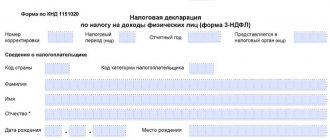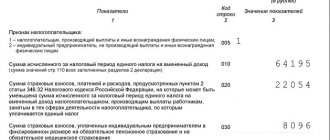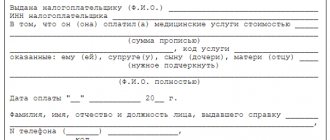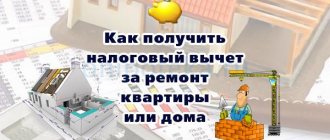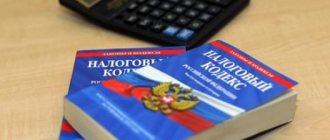What is a tax deduction and why do you get it?
A tax deduction is a certain amount of income that is not subject to tax, or a refund of part of the personal income tax (PIT) already paid in connection with some expenses incurred. The types of these expenses are determined by the Tax Code of the Russian Federation. Any citizen of the Russian Federation or a foreign citizen can receive a tax deduction if he lives in Russia for more than 183 days a year and pays tax on the income received.
Example!
Let's say you earned 1 million rubles in a year. and 13% was paid in income taxes. In the same year, you spent 100 thousand on your child’s education at the university. These 100 thousand are deducted from income, and it turns out that you had to pay tax not 130 thousand, but 13% of 900 thousand, that is, 117 thousand. The overpayment amounted to 13 thousand rubles - so they will return it to you.
What are social deductions
The concept of “deduction” implies a reduction in the taxable amount or a refund of part of the tax paid in order to reduce the financial burden on citizens. Only those citizens of the Russian Federation who pay personal income tax in the amount of 13% are entitled to take advantage of this benefit. Current social tax deductions are provided in accordance with Art. 219 of the Tax Code of the Russian Federation to those taxpayers who incurred expenses in the reporting period for:
- charity;
- treatment;
- education;
- sports and fitness;
- voluntary life insurance;
- non-state pension insurance.
When registering with the Federal Tax Service, the deduction is provided in the form of a refund of the amount to a bank account, and when contacting the employer, the personal income tax payable is simply reduced. Thus, the amount of social deductions provided by the employer in the reporting period is the right granted by the legislator to reduce the amount of tax paid by reducing the amount of taxable income. The legislator imposes special requirements on citizens wishing to receive benefits.
IMPORTANT!
The maximum total amount of all social deductions (except for deductions in the amount of expenses for children's education, charity and expensive treatment) cannot exceed 120,000 rubles per year. This is the amount of expenses from which 13% is returned - 15,600 rubles.
It is a misconception that unused social tax deductions can be carried forward to subsequent years. Such a norm is not provided for by the norms of the Tax Code of the Russian Federation, the Federal Tax Service reminded about this in a letter dated August 16, 2012 No. ED-4-3 / [email protected]
IMPORTANT!
From 01/01/2022, Federal Law No. 88-FZ dated 04/05/2021 amended Article 219 of the Tax Code of the Russian Federation on the introduction of a simplified procedure for providing tax deductions for personal income tax.
In some cases, tax authorities will provide them without a 3-NDFL declaration and a statement from the taxpayer. They will draw conclusions about the possibility of a tax refund based on the information they have at their disposal and inform citizens about this. Under these conditions, a tax deduction will be provided under the social contract - this is a refund of funds for voluntary life insurance. A similar procedure is provided for property deductions.
Leading regions in terms of the number of tax deductions provided (thousands)
Moscow
| 296,6 | |
| Sverdlovsk region | 294,4 |
| Tatarstan | 292 |
| Saint Petersburg | 254,1 |
| Moscow region | 248,3 |
Source: Federal Tax Service, data based on the results of 2022.
There are five types of personal income tax deductions:
- Standard (for children, veterans of the Great Patriotic War, disabled people, Chernobyl survivors, “Afghans”, Heroes of the USSR and Russia with state awards);
- Social (for charity, training, treatment, pension contributions to non-state pension funds, additional insurance contributions for funded pension);
- Property (sale, purchase, construction of housing, acquisition of land);
- Professional (for royalties, income of individual entrepreneurs, persons engaged in private practice);
- Investment (for the sale of securities).
It is permissible to claim a tax deduction for a specific year in several categories at the same time, for example, to receive it immediately for children, treatment, charity and sale of housing. You can apply for a deduction within three years after the tax period. That is, for example, in 2022 it will be possible to return the money for 2016, 2017 and 2022.
How to determine the amount of deduction
You can reduce your tax in one of two ways. The choice depends on the type of activity:
- Settlement deduction
allowed to all income tax payers. From the income received, subtract all expenses associated with its receipt. Provide documents that confirm the amounts and reality of the costs incurred. On the remaining amount, charge personal income tax 13%;You have contracted to renovate a room for 50,000 rubles.
The cost of the consumables you purchased for repairs is 20,000 rubles.
Subtract your costs: 50,000 – 20,000 = 30,000 rubles.
For the amount of 30,000 rubles, charge personal income tax: 30,000 x 13% = 3,900 rubles.
3,900 rubles is the amount of tax that must be paid to the budget.
- The deduction according to the standard
is intended for those who cannot confirm professional expenses. For individual entrepreneurs, it is equal to 20% of all income for the calendar year (paragraph 5 of article 221 of the Tax Code of the Russian Federation). For authors - varies from 20 to 40%. The standard deduction is not available to lawyers, private practitioners and those who work under a civil law agreement (CLA) (clauses 1, 2 of Article 221 of the Tax Code of the Russian Federation).
Who is allowed settlement deduction and deduction according to the standard?
You are an individual entrepreneur
Entrepreneurs on OSNO pay income tax like ordinary citizens. When combining OSNO with PSN or UTII, personal income tax, only those incomes that are not subject to special tax regimes are taxed.
The deduction includes only expenses that relate to business activities: costs of materials, storage and delivery of products, staff salaries. The full list is given in chap. 25 of the Tax Code of the Russian Federation and joint order of the Ministry of Finance and the Ministry of Taxes and Duties No. 86-n, No. BG-3-04/430 dated August 13, 2002.
In addition to the main costs, the deduction includes the amount of paid insurance premiums and interest on loans taken for business (letter of the Ministry of Finance dated December 7, 2015 No. 03-04-07/71364).
There are a number of expenses that an individual entrepreneur cannot deduct:
- land tax;
- VAT;
- tax on property used in the work of individual entrepreneurs (except for dachas, garages, apartments, residential buildings);
- expenses for the acquisition of land plots;
- bad debts;
- MTPL policies (with the exception of individual entrepreneurs who transport goods or passengers).
An example of personal income tax calculation using a professional deduction
The individual entrepreneur sells plumbing materials and makes custom designs for water supply and sewer systems. The purchase of goods for resale is confirmed by invoices and payment orders from the bank. There is nothing to confirm the costs of producing projects.
Business indicators for 2022: revenue from trade - 620,000 rubles, from project activities - 360,000 rubles, expenses for the purchase of plumbing products - 290,000 rubles.
We will carry out calculations and choose a profitable tax payment method.
Tax deduction calculation
Conclusion:
an entrepreneur will save 12,220 rubles (101,920 – 89,700) if he uses a professional deduction based on documents.
If your documented expenses exceed 20% of all income for the year, choose the method of calculating deductions based on documents.
If you work for UTII or PSN, check whether all your operations fall under special regimes. Otherwise, you risk additional personal income tax, VAT and penalties.
Case from practice.
As a result of a tax audit, an individual entrepreneur was charged additional VAT and personal income tax on his UTII.
The court supported the tax authorities and indicated that the nature of the individual entrepreneur’s activities indicated wholesale sales of goods. Wholesale trade excludes UTII taxation. On this basis, the taxpayer was assessed additional personal income tax, VAT, penalties and fines in the amount of 4,299,933 rubles.
During the audit, the individual entrepreneur provided primary documents confirming his expenses, so he was provided with a calculated professional deduction for personal income tax (resolution dated 08.08.2018 in case No. A44-10034/2017).
Do you work under civil contracts?
The deduction under the contract reduces personal income tax for those who perform household, construction, survey work, and provide services under contracts (Chapter 37 of the Tax Code of the Russian Federation, Chapter 39 of the Tax Code of the Russian Federation). Works are ordered by organizations, entrepreneurs and even citizens. When paying for work and services, the customer withholds 13% of personal income tax and transfers it to the budget.
If the work was performed for a citizen, you can receive a deduction from the tax office after filing a 3-NDFL declaration. In this case, you will have to calculate and pay the tax yourself.
There is no standard deduction for citizens, so keep documents about expenses. If you are making repairs, keep receipts for consumables; if you are hosting holidays, confirm expenses for travel and costumes. This is the only way you can save on income tax.
You are a lawyer
Lawyers pay personal income tax and have the right to a tax deduction. For private practitioners there is no deduction according to the standard. The tax is reduced only by the amount of costs supported by documents. Among the expenses for which a lawyer can reduce the tax base are payments for the needs of the bar association, travel and hotel expenses, payment for professional liability insurance, and educational expenses.
If you are taking courses or professional retraining, make sure that the educational institution has a license before concluding a contract. The organizers of the training must confirm its completion with a certificate or diploma, only then the lawyer is allowed to take into account these costs (letter of the Ministry of Finance dated June 2, 2022 No. 03-04-05/34533).
Not all attorneys' expenses can be taken into account. The tax office checks the documents and may refuse a deduction if it decides that the expenses are not entirely related to professional activities. For example, expenses for an electronic signature (ES) will be accepted only if its receipt is required under an agreement with the client. The purchase of office equipment also raises many questions among tax authorities; they refuse to include the purchase of a laptop in expenses, citing the fact that they are also used for personal purposes (letter of the Ministry of Finance of the Russian Federation dated January 25, 2018 No. 03-04-05/4446).
Lawyers working in the bar receive a deduction according to the rules that are established for citizens working under civil contracts (letter of the Ministry of Finance dated March 30, 2022 No. 03-04-05/20196).
You are a notary
Private notaries keep records of income and expenses in the same way as lawyers. They reduce the tax base for personal income tax on the basis of documents that confirm expenses.
Notaries' expenses include employee salaries, office rent and utility bills, contributions to the notary chamber, state fees, payments to an accountant, training costs and others (letter of the Ministry of Finance dated October 28, 2015 No. 03-04-07/61977).
You are an arbitration manager
An arbitration manager is a specialist who conducts bankruptcy procedures for citizens or organizations. Such activities are recognized as private practice and are not related to entrepreneurship (clause 1 of Article 20 of the Federal Law of October 26, 2002 No. 127-FZ “On Insolvency (Bankruptcy)”). This means that personal income tax must be paid on the entire remuneration of the arbitration manager (determination of the judicial panel of the Supreme Court of the Russian Federation dated January 21, 2015 No. 87-KG14-1).
The income of the arbitration manager consists of remuneration and reimbursement of expenses incurred by him in the conduct of bankruptcy. When calculating personal income tax, you can reduce income by confirmed expenses. This could include rent, state fees, and assistants’ salaries.
In addition, the arbitration manager reduces the tax on the cost of gasoline and depreciation of a personal car used for work trips. But the costs of purchasing MTPL or CASCO policies are not considered professional and are not accepted for deduction (letter of the Ministry of Finance of the Russian Federation dated July 18, 2017 No. 03-04-07/45582).
Case from practice.
The arbitration manager was registered as an individual entrepreneur. When calculating personal income tax, he reduced his income by 20% as a professional deduction. Based on the results of checking the declaration, the tax office refused the deduction and assessed additional personal income tax.
Having disagreed with this decision, the taxpayer went to court. The case reached the Supreme Court of the Russian Federation. In their ruling No. 306-KG17-9653 dated October 10, 2017, the judges indicated that the insolvency practitioner has the right to receive a deduction only in the amount of confirmed expenses.
It is possible to reduce personal income tax by the amount of reimbursed expenses only when they were actually reimbursed. For example, you incurred expenses for conducting a business in 2022, and received compensation in 2022. Such expenses can be included in the deduction for 2022 (letter of the Ministry of Finance dated February 22, 2022 No. 03-04-05/10448).
You are the author
The author not only creates artistic, musical or literary works, but also develops video content, writes scientific papers, and comes up with industrial designs. The author's income is a fee for the creation and royalties for the use of the result of his work. It is from this income that the author pays personal income tax.
It is almost impossible to document the costs of creating music or a film. In this case, cost standards will help. For each object of copyright they are different (clause 1, clause 3 of Article 221 of the Tax Code of the Russian Federation).
Cost standards
Example.
You have created the scenery for a theatrical production from customer materials. According to the agreement, the theater paid you 100,000 rubles. For this type of activity, a deduction standard of 40% of the author’s income is provided.
Exclude 40,000 rubles (100,000 × 40%) from the tax base.
Charge personal income tax (13%) on the remaining income of 60,000 rubles (100,000 - 40,000).
Calculate the tax payable: 60,000 × 13% = 7,800 rubles.
Personal income tax on the full amount of income: 100,000 × 13% = 13,000 rubles.
Savings: 13,000 – 7,800 = 5,200 rubles.
Personal income tax deductions are not available to authors for whom the creation of works and inventions is an official duty. A designer working at a research institute and creating a prototype will not receive a professional tax deduction (letter of the Ministry of Finance dated 06.06.2005 No. 03-05-01-04/177).
Deduction for the purchase of an apartment: documents, procedure for obtaining
Required documents:
- Identity card (passport of a citizen of the Russian Federation). If the tax return is submitted electronically, then an electronic signature (it can be easily obtained in your personal account on the website nalog.ru);
- Tax return in form 3-NDFL. The declaration template and instructions for filling out are available on the Federal Tax Service website;
- Application for tax refund. It can be drawn up when submitting a declaration to the tax office or taken a sample from the Federal Tax Service website. At the time of writing the application, you must choose a convenient option for returning a tax deduction - a one-time payment for the entire year, monthly payments or a reduction in the tax base in the future.
- Papers confirming the purchase of housing or expenses associated with it. This could be a purchase and sale agreement, an act of acceptance and transfer of premises, a loan agreement, a bank receipt, a check, a receipt;
- Papers confirming ownership of the purchased apartment. This could be an extract from the Unified State Register or a certificate of ownership;
- A document confirming the payment of personal income tax for the previous year (certificate in form 2-NDFL, it is obtained from the accounting department of your organization);
- Details certified by the bank to which your income tax refund will be transferred.
Important!
When submitting copies of papers confirming the right to deduction to the tax authority, you must have their originals with you for verification. Half of all problems when receiving money are due to the fact that the consumer does not have any documents.
When purchasing real estate, the tax base for deduction is limited to 2 million rubles. Thus, the tax benefit is 260 thousand rubles. Every citizen has the right to a benefit of up to 2 million rubles. just one time.
If it was fully used when purchasing the first property, then the benefit will not be provided when purchasing a second property.
If the apartment was purchased at the expense of the employer, maternity capital or the budget, then the deduction cannot be taken.
Property deductions can be used to pay off interest on a mortgage loan. In this case, the deduction limit increases from 260 thousand to 390 thousand rubles.
The deduction includes not only the purchase or construction itself, but also the finishing of the apartment, laying communications and developing the project.
Limits of property tax deductions
The right to receive a property tax deduction arises for a taxpayer who, in the past year:
- Purchased a house or apartment (part of a house or share in an apartment).
- Made expenses for the purchase of construction or finishing materials. In this case, the purchase and sale agreement must contain a clause stating that the house or apartment is purchased unfinished or without finishing.
- Incurred expenses for the preparation of design estimates for the construction of the house.
Obtaining a tax deduction for the purchase of a land plot is possible only if the plot was purchased together with a house. Otherwise, it is possible to reimburse part of the costs after building a house and obtaining a certificate of ownership of the house, and only when the site is intended for individual construction (subclause 3, clause 1, article 220 of the Tax Code of the Russian Federation).
The limit for receiving a property deduction is the amount of 2 million rubles. It does not include interest on mortgage loans obtained from Russian banks, for which their own limit is set - 3 million rubles.
You can receive a property deduction, like a social one, from your employer this year upon notification issued by the Federal Tax Service, or directly from the Federal Tax Service at the end of the year (or several years).
If the taxpayer claims both property and social deductions, the procedure for their provision is determined by the employer. The Federal Tax Service recommends that employers be advised in what order it is best to take tax deductions.
If you intend to receive a deduction from the Federal Tax Service, you will need to submit a 3-NDFL declaration for the past year.
Starting from 01/01/2014, for legal relations that arose after this date, parents can receive a deduction, including for property owned in whole or in part by a minor.
How the volume of tax deductions received in Russia grew (billion rubles)
| 170,8 | 11 | |
| 2014 | 121,9 | 7,4 |
| 2011 | 56 | 6,1 |
Russian tax legislation provides two ways to obtain a tax deduction:
- through the tax office;
- through the employer.
First way
involves the return of tax paid in the past to the person’s bank account.
In the second option
the tax deduction is repaid by canceling income tax deductions from the employee’s salary. Which one is more convenient is up to you to decide.
Procedure:
- Fill out a tax return (form 3-NDFL).
- Obtain a certificate from the accounting department at your place of work about the amounts of accrued and withheld taxes for the year in form 2-NDFL.
- Collect copies of papers confirming the right to housing (see above).
- Collect copies of payment documents (see above).
- When purchasing an apartment in joint ownership, collect copies of the marriage certificate and a written statement about the agreement of the parties involved in the transaction on the distribution of the amount of the deduction between the spouses. The deduction distribution agreement does not need to be notarized.
- Submit a completed tax return with copies of all documents to the tax authority at your place of residence. The tax office will let you fill out an application (request two copies, one will be left for you) and send the documents for a three-month audit. It is convenient to monitor the result in your personal account on the Federal Tax Service website - information about overpayment of tax will appear there. After this, you can wait for the money to arrive in your account - no more than a month.
Deduction for treatment: documents, procedure
General list of required documents:
- Copy of Russian passport;
- Tax return in form 3-NDFL (to be completed by the taxpayer);
- Certificate of income from the main place of work (form 2-NDFL), certificates of part-time income (if any, issued by employers);
- An application to the Federal Tax Service with details (on bank letterhead with a stamp) to which the tax will be refunded.
When treated in a hospital or clinic:
- Agreement with a medical institution (there must be an exact amount paid for treatment) - original and copy;
- A certificate from the hospital/clinic/medical center confirming payment under the contract (must contain the patient’s medical card number and TIN, as well as the treatment category code: “1” - ordinary, “2” - expensive);
- A copy of the medical institution's license.
When purchasing medications:
- The original prescription with the stamp “For tax authorities”, issued by a doctor or the administration of a medical institution;
- Checks, receipts, payment orders confirming payment for drugs;
- If a patient purchased expensive medications necessary for treatment because they were not available at the medical institution, a certificate about this must be drawn up from the administration of the medical organization.
When concluding a voluntary health insurance agreement by an individual:
- A copy of the voluntary insurance agreement;
- A copy of the insurance company's license;
- Receipt for payment of insurance premium.
Procedure (when contacting an employer):
- Write an application to receive a notification from the tax authority about the right to a social deduction.
- Prepare copies of papers confirming the right to deduction (see above).
- Submit an application to the tax authority at your place of residence for notification of the right to a social deduction.
- After 30 days, obtain a notification from the tax authority about the right to a social deduction.
- Submit a notice issued by the tax authorities to the employer; it will become the basis for non-withholding of personal income tax from the amount of paid income until the end of the year.
Regulatory regulation and stages of personal income tax return
To solve the problem, you first need to consider the regulatory regulation of personal income tax returns. The procedure for returning personal income tax to the taxpayer is described in Art. 231 Tax Code of the Russian Federation.
Stages of personal income tax return:
- excessively withheld personal income tax was detected;
- inform the employee about this within 10 working days;
- the employee must write a statement;
- within 3 months the organization must return personal income tax;
- Personal income tax refunds are made strictly to the employee’s bank account, i.e. You cannot return personal income tax through the cash desk.
Child deduction: documents, procedure
To receive a “children’s” deduction, it is not necessary to go to the tax office. It is enough to contact the accounting department at your place of work with a corresponding application. The simple procedure makes this deduction the most popular among the population. Usually the employer is asked to apply for this deduction from the beginning of the year, but you can also claim it retroactively through the Federal Tax Service.
The deduction for a child (children) is provided up to the month in which the taxpayer’s income, taxed at a rate of 13% and calculated on an accrual basis from the beginning of the year, exceeded 350 thousand rubles. The deduction is canceled from the month when the employee’s income exceeds this amount.
For the first and second child, a deduction of 1,400 rubles is allowed; for the third and each subsequent child - 3,000 rubles. For each disabled child under 18 years of age, or a full-time student, graduate student, resident, intern, student under the age of 24, if he is a disabled person of group I or II - 12,000 rubles. parents and adoptive parents (RUB 6,000 for guardians and trustees).
General list of required documents:
- A written application addressed to your employer requesting a tax deduction for the child(ren);
- Birth certificate of the child (or children). This also applies to adopted children; here you need a copy of the adoption certificate;
- Certificates of child disability, if the child is one;
- Certificates from the child’s place of education (subject to receiving a deduction for a child over 18 years of age studying full-time at an educational institution);
- Marriage certificate.
Procedure:
- Write an application for a standard tax deduction for a child (children) addressed to the employer.
- Prepare copies of papers (see above).
- If the employee is the only parent, the kit must be supplemented with a copy of a document confirming this fact (perhaps the death certificate of the second parent).
- If the employee is a guardian or trustee, the kit must be supplemented with a copy of the document on guardianship or trusteeship.
- Contact your employer with an application for a standard tax deduction and copies of all papers.
Important!
If the taxpayer has several employers, he will have to choose. If there is only one parent, he is entitled to double the deduction. One of the spouses can also receive a double amount if the other refuses the deduction in writing. However, if the second spouse simply does not have taxable income, and therefore no right to deduction, then the first spouse cannot count on double the amount.
Standard
This tax deduction is provided to workers for participating in any actions, for example, participants and liquidators of emergency situations, disabled people and war veterans. Parents of minor children are also entitled to claim benefits. Please note that not only natural parents, but also guardians, adoptive parents, and legal representatives of children can take advantage of the standard type of benefits.
The dimensions and terms of provision are set out in Art. 218 Tax Code of the Russian Federation:
- Liquidators of the Chernobyl disaster and those affected by it, as well as liquidators of the consequences of nuclear tests, can apply for 3,000 rubles (that’s 390 rubles monthly). Disabled veterans of the Second World War, as well as military personnel who were injured in the line of duty.
- Heroes of the USSR and the Russian Federation, disabled people of the first and second categories, combatants (an appropriate certificate will be required), as well as other categories of citizens named in paragraph 2 of Art. 218 Tax Code of the Russian Federation.
If a citizen claims two benefits at once, then only one tax deduction is provided, but in the maximum amount.
Tax benefits for children per month are:
- 1500 rub. - for the first and second child;
- 3000 rub. - for the third and subsequent minors;
- 12,000 rub. — for a disabled child of group 1 or 2 for natural parents and adoptive parents;
- 6000 rub. - for a disabled minor for guardians and trustees.
Let us remind you that a tax deduction is due for each minor, as well as full-time students up to 24 years of age inclusive. If children are raised by a single parent, the benefits are doubled.
IMPORTANT!
There is a limit on children's benefits of 350,000 rubles per year per parent (guardian, trustee, adoptive parent). That is, the tax deduction will not be provided from the month in which the parent’s income exceeds the established threshold. For example, with a salary of 50,000 rubles per month, benefits will be provided for seven full months (from January to July).
In order to receive a standard tax deduction, an employee must prepare and submit an application for its provision to the head of the organization. Each application is accompanied by legal documents - birth certificates of children, ID of a disabled person or veteran, etc.
Deduction for training: documents, procedure
The standard package for applying for a tax deduction for education includes:
- Copy of Russian passport;
- Tax return in form 3-NDFL;
- A certificate of income for all places of work in the reporting year where the employer paid income tax for you (form 2-NDFL) is issued by the accounting department of the organization where you worked;
- A copy of the agreement with the educational institution addressed to the payer;
- A copy of the license of the educational organization, certified by its seal (if there is information about the license in the contract, this copy does not need to be attached);
- Copies of receipts, checks or other payments confirming payment for educational services;
- An application to the Federal Tax Service with a request to return the tax amount and details where it should be transferred.
Procedure:
- Fill out a tax return (form 3-NDFL) at the end of the year in which tuition was paid.
- Obtain a certificate from the accounting department at your place of work about the amounts of accrued and withheld taxes for the year in form 2-NDFL.
- Prepare a copy of the agreement with the educational institution for the provision of educational services, which specifies the details of the license to carry out educational activities. If the cost of training increases, a copy of the document confirming the increase in cost, for example, an additional agreement to the contract.
- Prepare copies of payment receipts confirming funds paid for training (cash register receipts, cash receipt orders, payment orders).
- Submit a completed tax return with copies of all collected papers to the tax authority at your place of residence.
Important!
The deduction is due only when paying for full-time education. You will be able to reimburse expenses for your education, the education of your children, including those under your care, as well as brothers and sisters. But for grandchildren, nephews, spouses - it’s impossible.
Evgeny Kozichev
